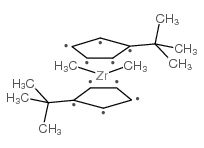DIMETHYLBIS(T-BUTYLCYCLOPENTADIENYL)ZIRCONIUM
Modify Date: 2024-01-15 08:02:02

DIMETHYLBIS(T-BUTYLCYCLOPENTADIENYL)ZIRCONIUM structure
|
Common Name | DIMETHYLBIS(T-BUTYLCYCLOPENTADIENYL)ZIRCONIUM | ||
|---|---|---|---|---|
| CAS Number | 68193-40-8 | Molecular Weight | 363.69200 | |
| Density | N/A | Boiling Point | N/A | |
| Molecular Formula | C20H32Zr | Melting Point | N/A | |
| MSDS | N/A | Flash Point | N/A | |
| Name | 2-tert-butylcyclopenta-1,3-diene,carbanide,zirconium(4+) |
|---|
| Molecular Formula | C20H32Zr |
|---|---|
| Molecular Weight | 363.69200 |
| Exact Mass | 362.15500 |
| LogP | 6.04320 |
|
Section 1: Product Identification Chemical Name:Dimethylbis(t-butylcyclopentadienyl)zirconium, min. 98% CAS Registry Number:68193-40-8 Formula:[(C4H9)C5H4]2Zr(CH3)2 EINECS Number:none Chemical Family:metallocene Synonym:Zirconium, dimethylbis[(1,2,3,4,5-.eta.)-t-butyl-2,4-cyclopentadiene-1-yl]
Section 2: Composition and Information on Ingredients IngredientCAS NumberPercentACGIH (TWA)OSHA (PEL) Title compound68193-40-8100%5mg/m3 (as Zr)5mg/m3 (as Zr) Section 3: Hazards Identification Emergency Overview:Irritating to skin, eyes, and respiratory tract. Primary Routes of Exposure:Skin, eyes, inhalation Eye Contact:Causes mild to moderate irritation of the eyes. Skin Contact:Causes slight to mild irritation of the skin. Inhalation:Dust is irritating to the nose, mucous membranes and respiratory tract. Ingestion:No information is available on the physiological effects of ingestion. Acute Health Affects:Irritating to skin, eyes and respiratory tract. Chronic Health Affects:No information available on long-term chronic effects. NTP:No IARC:No OSHA:No SECTION 4: First Aid Measures Immediately flush the eyes with copious amounts of water for at least 10-15 minutes. A victim may need Eye Exposure: assistance in keeping their eye lids open. Get immediate medical attention. Wash the affected area with water. Remove contaminated clothes if necessary. Seek medical assistance if Skin Exposure: irritation persists. Remove the victim to fresh air. Closely monitor the victim for signs of respiratory problems, such as difficulty in Inhalation: breathing, coughing, wheezing or pain. In such cases seek immediate medical assistance. Seek medical attention immediately. Keep the victim calm. Give the victim water (only if conscious). Induce Ingestion: vomiting only if directed by medical personnel. SECTION 5: Fire Fighting Measures Flash Point:none Autoignition Temperature:none Explosion Limits:none Extinguishing Medium:carbon dioxide, foam or dry powder If this product is involved in a fire, firefighters should be equipped with NIOSH approved positive pressure Special Fire Fighting Procedures: self-contained breathing apparatus. Hazardous Combustion andIf involved in a fire this material may emit toxic organic fumes. Decomposion Products: Unusual Fire or Explosion Hazards: No unusual fire or explosion hazards. SECTION 6: Accidental Release Measures Spill and Leak Procedures:Small spills can be mixed with vermiculite or sodium carbonate and swept up. SECTION 7: Handling and Storage The material will degrade on prolonged exposure to air and moisture. Store under an inert atmosphere of Handling and Storage: nitrogen or argon. Keep bottle tightly sealed and away from heat and light. SECTION 8: Exposure Controls and Personal Protection Eye Protection:Always wear approved safety glasses when handling a chemical substance in the laboratory. Skin Protection:Wear protective clothing and gloves. Ventilation:If possible, handle the material in an efficient fume hood. If ventilation is not available a respirator should be worn. The use of respirators requires a Respiratory Respirator: Protection Program to be in compliance with 29 CFR 1910.134. Ventilation:If possible, handle the material in an efficient fume hood. Additional Protection:No additional protection required. SECTION 9: Physical and Chemical Properties Color and Form:pale yellow powder Molecular Weight:363.7 Melting Point:no data Boiling Point:no data Vapor Pressure:no data Specific Gravity:no data Odor:none Solubility in Water:reacts with water SECTION 10: Stability and Reactivity Stability:air and moisture sensitive Hazardous Polymerization:No hazardous polymerization. Conditions to Avoid:none Incompatibility:water, air, oxidizing agents, halogens Decomposition Products:zirconium oxide, carbon monoxide, carbon dioxide, and organic fumes. SECTION 11: Toxicological Information RTECS Data:No information available in the RTECS files. Carcinogenic Effects:no data Mutagenic Effects:no data Tetratogenic Effects:no data SECTION 12: Ecological Information Ecological Information:No information available SECTION 13: Disposal Considerations Disposal:Dispose of according to local, state and federal regulations. SECTION 14: Transportation Shipping Name (CFR):Non-hazardous Hazard Class (CFR):NA Additional Hazard Class (CFR):NA Packaging Group (CFR):NA UN ID Number (CFR):NA Shipping Name (IATA):Non-hazardous Hazard Class (IATA):NA Additional Hazard Class (IATA):NA Packaging Group (IATA):NA UN ID Number (IATA):NA SECTION 15: Regulatory Information TSCA:Not listed in the TSCA inventory. SARA (Title 313):Title compound not listed Second Ingredient:none SECTION 16 - ADDITIONAL INFORMATION N/A |